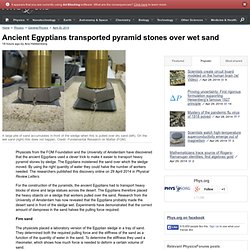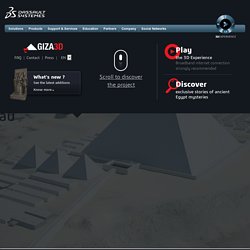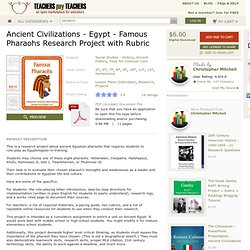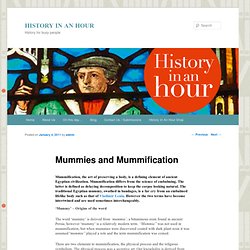

Ancient Egyptians transported pyramid stones over wet sand. Physicists from the FOM Foundation and the University of Amsterdam have discovered that the ancient Egyptians used a clever trick to make it easier to transport heavy pyramid stones by sledge.

The Egyptians moistened the sand over which the sledge moved. By using the right quantity of water they could halve the number of workers needed. The researchers published this discovery online on 29 April 2014 in Physical Review Letters. Theban Mapping Project. Ancient Egypt: Home. The unbroken seal on Tutankhamun's tomb 1922. 3,245 years untouched. Ancient Egypt Culture.
S Tomb at neferchichi.com. The history of hieroglyphic writing So you want to write like an Egyptian, huh?

Well it took several years for aspiring scribes to learn how to do it, so for the sake of time we'll just cover the basics. Hieroglyphic writing first began around 5000 years ago. Egyptians wrote in hieroglyphs up to about 400 AD, after that they wrote in a short-hand cursive style called demotic. Eventually everyone forgot how to write in hieroglyphs. But now we are able to decipher hieroglyphs thanks to a special chunk of rock and a determined Egyptologist. People realized that the three languages on "The Rosetta Stone" said the same thing. Finally, in 1822, a French Egyptologist named Jean François Champollion figured out how to decipher hieroglyphic writing. Secrets of the Pharaohs: resources. Giza 3D - Dassault Systèmes. 3841 tombs and monuments listed.

AncientEgyptMap.jpg (841×1474) History - Ancient Egyptian Gods Gallery. Ancient Egypt Famous Pharaohs Research Project WITH Rubric - MisterMitchell.com. This is a research project about ancient Egyptian pharaohs that requires students to role-play as Egyptologists-in-training.

Students may choose one of these eight pharaohs: Akhenaten, Cleopatra, Hatshepsut, Khufu, Ramesses II, Seti I, Tutankhamen, or Thutmose III. Their task is to evaluate their chosen pharaoh's strengths and weaknesses as a leader and their contributions to Egyptian life and culture. Here are some of the specifics: For students: the role-playing letter introduction, step-by-step directions for implementation (written in plain English for students to easily understand), research logs, and a works cited page to document their sources. For teachers: a list of required materials, a pacing guide, two rubrics, and a list of reputable online resources for students to use when they conduct their research.
This project is intended as a cumulative assignment to enrich a unit on Ancient Egypt. Last, if you like this offering, would you kindly consider reviewing it for others? WEB SITES ON ANCIENT EGYPT FOR TEACHERS AND STUDENTS. Access these sites through your computer’s Internet connection. Open the underlined address (URL). Information can be printed or downloaded to your computer. Be sure to follow links to other sites and find your way back with the "back" button. Ancient Egyptian History. Prehistoric Egypt The Prehistory of Egypt spans the period of earliest human settlement to the beginning of the Early Dynastic Period of Egypt in ca. 3100 BC, starting with King Menes/Narmer. The Predynastic Period is traditionally equivalent to the Neolithic period, beginning ca. 6000 BC and including the Protodynastic Period (Naqada III).
The dates of the Predynastic period were first defined before widespread archaeological excavation of Egypt took place, and recent finds indicating very gradual Predynastic development have led to controversy over when exactly the Predynastic period ended. Thus, the term “Protodynastic period,” sometimes called “Dynasty 0,” has been used by scholars to name the part of the period which might be characterized as Predynastic by some and Early Dynastic by others.
Ancient Egypt: an introduction to its history and culture. Ancient Egypt Web Site. Mummies and Mummification. ‘Mummy’ – Origins of the word The word ‘mummy’ is derived from ‘mummia’, a bituminous resin found in ancient Persia; however ‘mummy’ is a relatively modern term.

“Mummia” was not used in mummification, but when mummies were discovered coated with dark plant resin it was assumed“mummia” played a role and the term mummification was coined. There are two elements to mummification, the physical process and the religious symbolism. The physical process was a secretive art. Our knowledge is derived from ‘reverse engineering’ of the many mummies that survived. Explore Ancient Egypt. Mummification. King Tut. Untitled Document. Includes Pyramids, Pharaohs, Queens, and More! Egyptian pyramids facts and information. Egyptian pyramids are great monument of a great civilization that was born seven thousand years ago.

The ancient Egyptians built more than 90 royal pyramids, from about 2630 BC until about 1530 BC. During that time, the pyramid shape evolved from a series of stepped terraces to sloped pyramidal shape. When were Egyptian pyramids built? The first pyramid, the Step Pyramid at Saqqara, was constructed during the reign of King Djoser (Zoser) (2630 BC-2611 BC). The largest pyramid in Egypt is the one built for King Khufu, in Giza. Why were Egyptian pyramids built? Egyptian pyramids were originally built to serve as tombs for kings and queens.
Egypt Pyramids Pharaohs Hieroglyphs - Mark Millmore's Ancient Egypt. Ancient Egypt - Gods, Pyramids, Mummies, Pharaohs, Queens, Hieroglyphics, History, Life in Ancient Egypt, Maps.